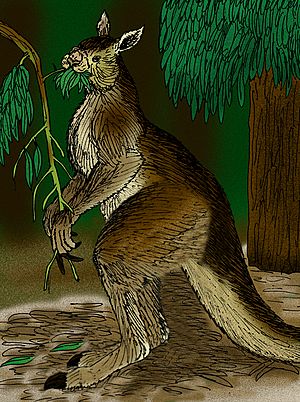Procoptodon facts for kids
Quick facts for kids Procoptodon |
|
|---|---|
 |
|
| Artist's impression of Procoptodon goliah | |
| Scientific classification |
|
| Kingdom: | Animalia |
| Phylum: | Chordata |
| Class: | Mammalia |
| Infraclass: | Marsupialia |
| Order: | Diprotodontia |
| Family: | Macropodidae |
| Subfamily: | †Sthenurinae |
| Genus: | †Procoptodon Owen, 1873 |
| Species | |
|
|
Procoptodon was a type of giant, short-faced kangaroo that lived in Australia. These amazing animals roamed the land during the Pleistocene epoch, which was a long time ago!
Scientists believe Procoptodon was quite different from the kangaroos we see today. They were much larger and had unique features that helped them survive in their ancient environment.
Contents
Procoptodon: The Giant Kangaroo
Procoptodon was a genus (a group of related species) of kangaroos. They are often called "short-faced" kangaroos because their faces were shorter and wider than modern kangaroos. This gave them a very distinct look.
These giant kangaroos lived alongside other large animals in prehistoric Australia. They were an important part of the ecosystem before they eventually disappeared.
How Big Were They?
The biggest species, Procoptodon goliah, was truly enormous! It was the largest kangaroo ever known. This giant stood about 2 m (6.6 ft) tall. That's taller than most people!
Procoptodon goliah also weighed a lot, around 200–240 kg (440–530 lb). Imagine a kangaroo as heavy as a small car! Because of their great weight, scientists think they might not have hopped like modern kangaroos. Instead, they might have walked or moved in a different way.
Not all Procoptodon species were so huge. For example, Procoptodon gilli was the smallest. It was only about 1 m (3 ft 3 in) tall, which is still a good size for a kangaroo.
What Did They Eat?
Unlike many modern kangaroos that eat mostly grass, Procoptodon were browsers. This means they ate leaves from trees and shrubs. They used their strong jaws and teeth to munch on tough plant material.
One of their main food sources was saltbushes. These plants are common in dry areas. Eating saltbushes meant Procoptodon goliah needed plenty of fresh water. This water helped them process the salty diet.
Why Did They Disappear?
Scientists believe a combination of factors led to the disappearance of Procoptodon. One big reason was climate change. The climate in Australia became cooler and drier. This caused forests and shrublands, where Procoptodon found their food, to shrink. Less food meant less habitat for these large animals.
Another possible factor was hunting by early humans. As aboriginal people arrived in Australia, they might have hunted these large, slow-moving kangaroos. This could have put extra pressure on their populations.
Images for kids
See also
 In Spanish: Procoptodon para niños
In Spanish: Procoptodon para niños



